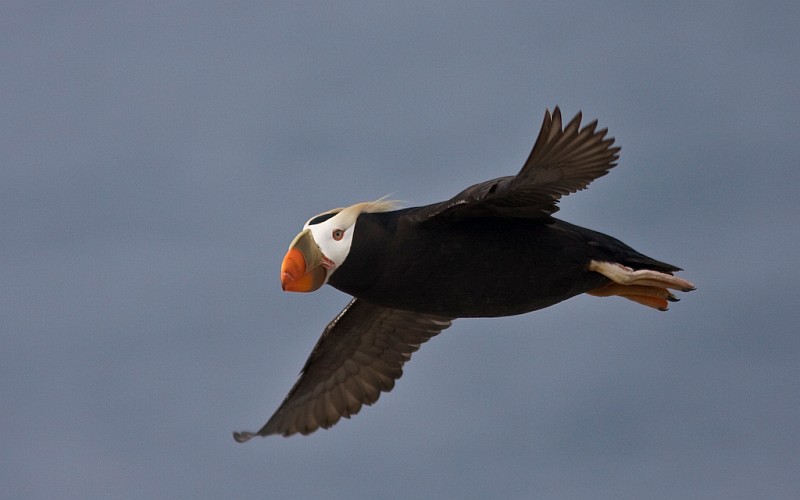
All photos for this article taken by Ron LeValley
www.LeValleyPhoto.com
AT THE MENDOCINO HEADLANDS, THE TUFTED PUFFINDonald ShephardWhen I first saw the birds that rest or nest on the islands north of Goat Rock in Mendocino Headlands State Park, they looked like a massive game of chess with many extra pieces. From a distance, the Common Murres and cormorants look entirely black and the gulls appear white. So my wife and I called it Chess Rock, but it has no name.
You may spot a less common bird there, the Tufted Puffin, a Northern Pacific sea bird that spends a majority of the year over the Pacific Ocean, but nests along coastlines from northern California to Alaska, and across the ocean from Japan to the shores of northeastern Asia. These medium-sized, stocky seabirds with rounded heads appear solid brown-black overall, except for distinctive facial coloration and orange feet. Yellow, and sometimes green, accents the base of the large orange, laterally compressed beak. In breeding plumage, both male and female Tufted Puffins sport a white mask across the face, ending in a tuft of blonde feathers sweeping back from above the ear. To distinguish this species from other puffins, look for its dark belly.
Tufted Puffins weigh nearly twice as much as pigeons, about a pound and a half. Once airborne, they fly well, but these heavy-set birds appear clumsy walking and need a slope and a running start for lift-off. They dive and swim underwater for a half minute or so, using their wings to paddle and their feet to steer their way through schools of small fish, which they catch in their bills. Sometimes a parent puffin will carry a dozen or more fish by using their tongues to hold fish against the spiny palate in their mouth while opening their beak to catch more fish. In flight, they look like flying cigars, moving rapidly and close to the waves.
Where they go in the winter is still not well known. We think they winter far out at sea, but few people have ever seen numbers of puffins in the winter. Occasionally there will be a landfall of both Horned and Tufted Puffins in the winter, presumably because ocean conditions get them to wandering to look for food.Where they go in the winter is still not well known. We think they winter far out at sea, but few people have ever seen numbers of puffins in the winter. Occasionally there will be a landfall of both Horned and Tufted Puffins in the winter, presumably because ocean conditions get them to wandering to look for food.
They breed in colonies on islands with steep, grassy slopes or on cliff tops and winter 60-120 miles offshore. Tufted Puffins probably form long-term pair bonds. They nest in burrows at the edges of cliffs, on grassy slopes, or in natural crevices in rocks. The pair spends a great deal of time preparing the nest site. The 2-7 feet burrow ends with a nest chamber lined with grass or feathers, or sometimes nothing at all. Scratching out the nest burrow with the sharp claws on their webbed feet consumes so much time that the birds most likely do not breed in the season in which they dig the burrow, but wait until the following year.
Tufted puffins court by flying straight upwards, called sky pointing, by strutting, and by rubbing their bills together. When the pair finally breeds, usually in April, the female lays one off-white egg, sometimes with faint blue and brown markings, usually between late April and early June. Both parents incubate for 6-1/2 to 7-1/2 weeks and care for the young for another 6-7 weeks, after which time the fledgling leaves its burrow at night and moves to sea. Most young birds, not yet capable of flight, walk, or flutter to sea, without parental aid.
Young puffins remain at sea almost two years. They become sexually mature at the age of three, but most do not mate until their four year. Their waterproof feathers and their ability to drink salt water and catch fish make staying long periods on the sea possible. They disperse widely while at sea but return to the colony where they were born, and usually to the same mate, every year for breeding.
When breeding ends in the early summer, puffins lose their plumes, the bright colors of the bill turn to a dull reddish-brown, and the belly becomes flecked in pale brown while their legs and feet remain red or orange-red throughout the year.
The major predators of Tufted Puffins, Snowy Owls, Bald Eagles and Arctic Foxes, present no problems here at the Mendocino Headlands State Park.
A group of puffins has many collective nouns, including a "burrow", "circus", "colony", "improbability", and "puffinry" of puffins. For my part, I'll settle for the name Improbability Island, for the home of this tufted cartoonish character.

Back to ... Mendocino Coast Audubon Society Newsletter Articles | Home page